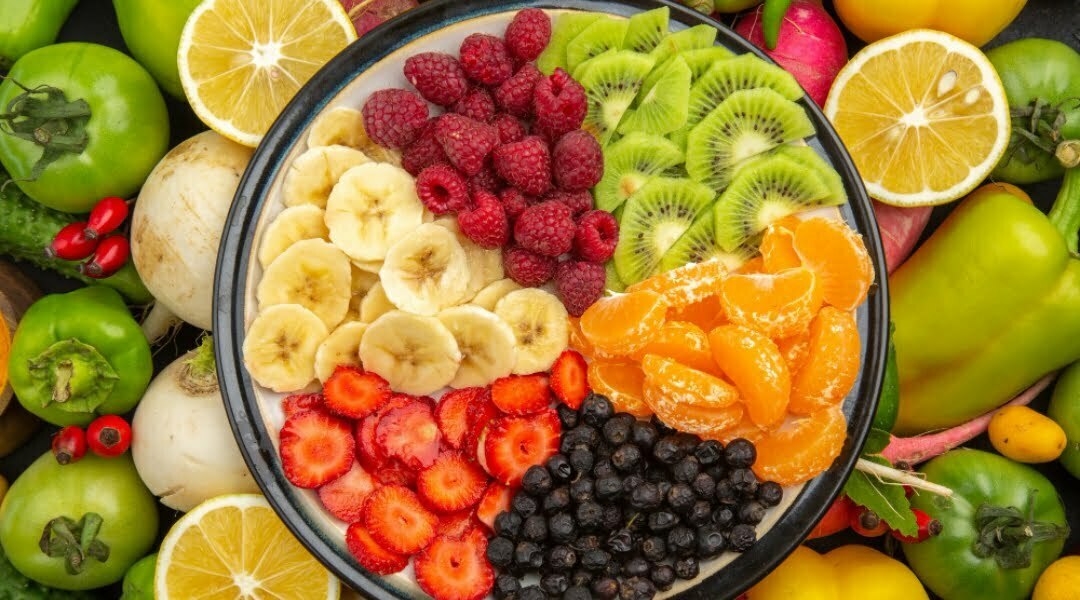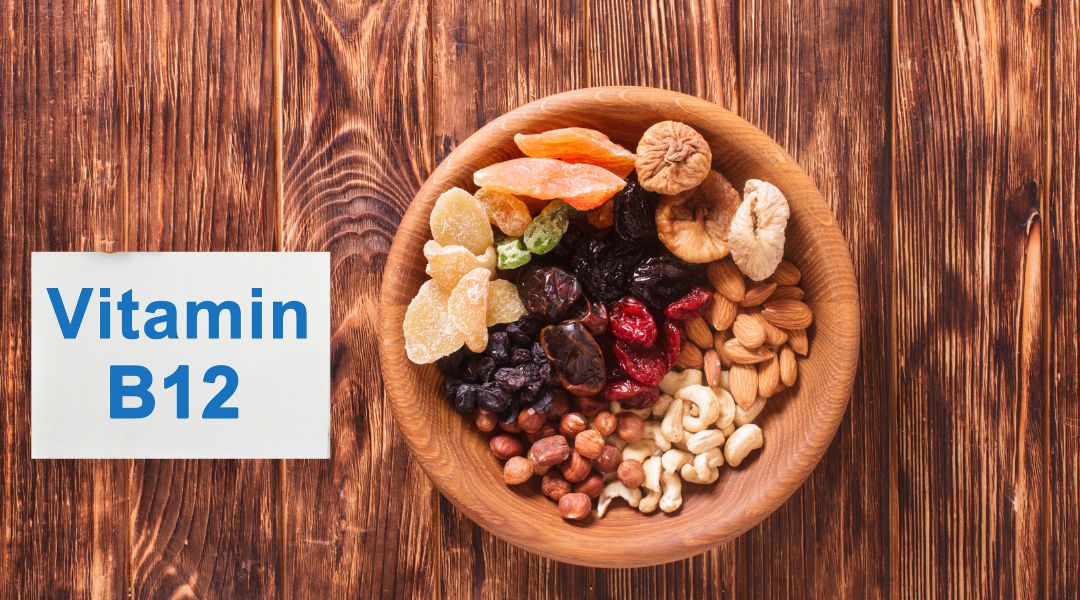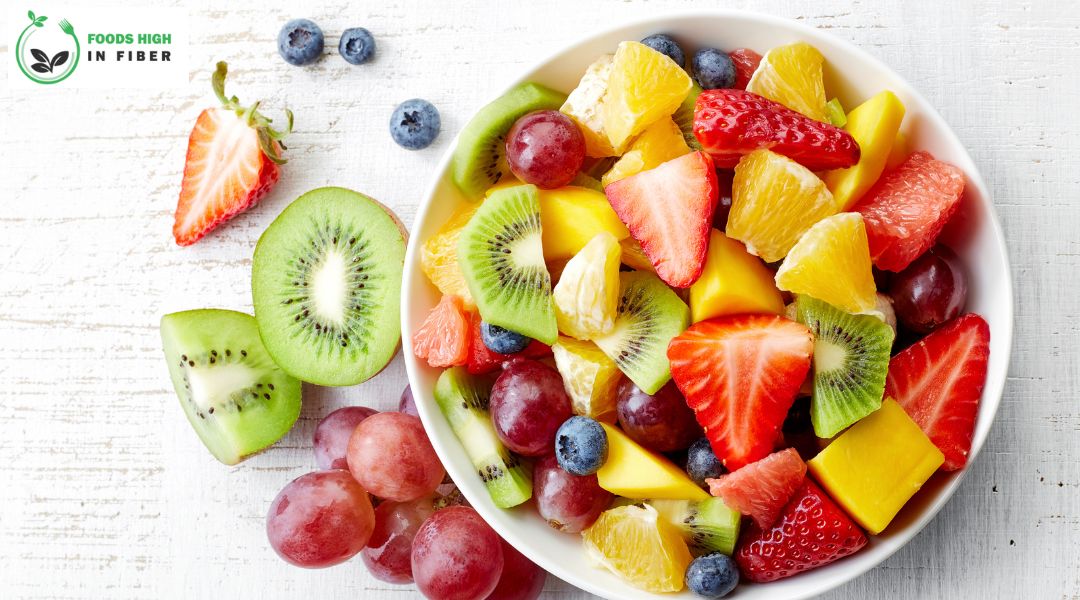Introduction
High fiber fruits are a great way to boost your daily fiber intake. Fiber is an important nutrient that helps keep your digestive system healthy, and it can also help you feel full and satisfied after eating.
Importance of fiber in a healthy diet
Fiber is an essential component of a healthy diet and plays a vital role in maintaining overall health and well being. It is a type of carbohydrate that cannot be digested by the body’s enzymes, but it is still crucial for various bodily functions. Including an adequate amount of fiber in your diet can have numerous benefits and contribute to a healthy lifestyle.
Benefits of high fiber fruits
- Promotes Digestive Health:
Fiber adds bulk to the stool, which helps regulate bowel movements and prevents constipation. It also supports growth of beneficial gut bacteria, improving overall digestive health. - Weight Management:
High fiber fruits are often low in calories and can help you feel fuller for longer, reducing overeating and aiding in weight management. The fiber content slows down digestion, promoting satiety and preventing excessive calorie consumption. - Blood Sugar Regulation:
High fiber fruits have a positive impact on blood sugar levels. Soluble fiber found in fruits forms a gel-like substance in digestive system, slowing down absorption of glucose into the bloodstream. This can help stabilize blood sugar levels and reduce risk of developing type 2 diabetes. - Heart Health:
High fiber fruits has been linked to a reduced risk of heart disease. Soluble fiber helps lower LDL cholesterol levels (“bad” cholesterol) by binding to it and eliminating it from body. By reducing cholesterol levels, fiber can help maintain cardiovascular health. - Improved Gut Health:
The consumption of high-fiber fruits promotes a healthy gut microbiome. Fiber acts as a prebiotic, providing nourishment for beneficial bacteria in the colon. A balanced gut microbiota has been associated with improved immunity, better nutrient absorption, and lower inflammation. - Reduced Risk of Chronic Diseases:
Including high fiber fruits in your diet may decrease the risk of developing various chronic diseases such as obesity, certain types of cancer (e.g., colorectal cancer), and cardiovascular conditions.
By incorporating a variety of high-fiber fruits into your daily diet, you can enjoy these benefits and support your overall health and well being.
Top 10 High Fiber Fruits
These are the following high fiber fruits:
I. Apple
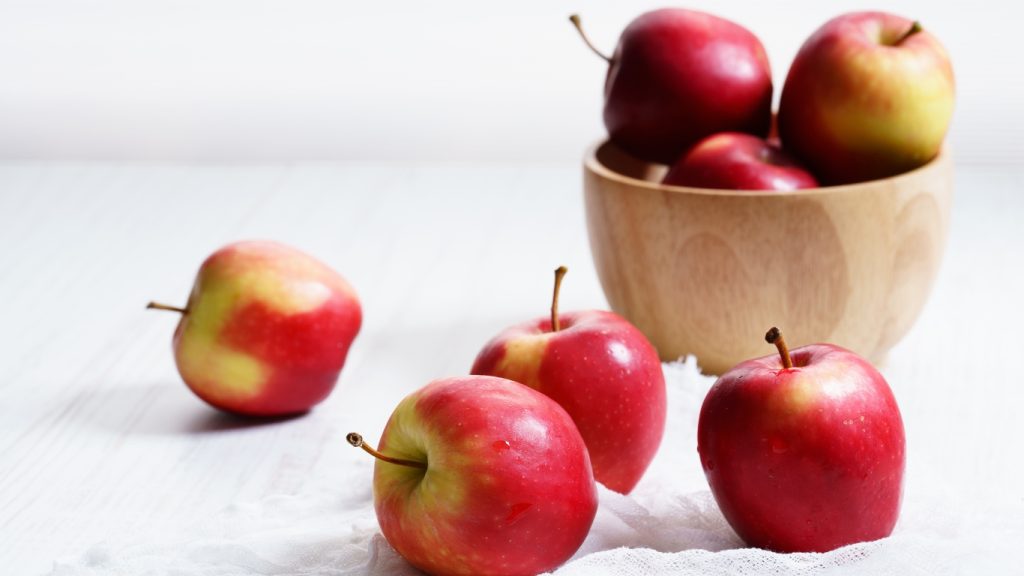
These are the following nutritional and health benefits of apple:
A. Nutritional value and fiber content:
- Apples are a rich source of essential nutrients, including dietary fiber, vitamins, and minerals.
- A medium-sized apple (about 182 grams) contains approximately:
- Calories: 95
- Fiber: 4 grams
- Vitamin C: 14% of recommended daily intake (RDI)
- Vitamin A: 2% of RDI
- Potassium: 6% of RDI
B. Health benefits:
- High fiber content: Apples are known for their high fiber content, particularly soluble fiber called pectin. High fiber fruits promotes healthy digestion, prevents constipation, and supports gut health.
- Weight management: The fiber in apples helps you feel full for longer, reducing hunger cravings and aiding in weight management.
- Heart health: Apples contain antioxidants and flavonoids that may help lower the risk of heart disease by reducing cholesterol levels and improving blood pressure.
- Blood sugar regulation: The soluble fiber in apples slows down absorption of sugar into the bloodstream, promoting stable blood sugar levels.
- Antioxidant properties: Apples are rich in antioxidants, such as quercetin, which help protect cells from oxidative damage and inflammation.
C. Ways to incorporate apples into the diet:
- Raw: Enjoy a fresh, crisp apple as a snack on its own or paired with a healthy dip, such as nut butter or yogurt.
- Salads: Add sliced apples to green salads or fruit salads for a refreshing and crunchy twist.
- Smoothies: Blend apples with other fruits, vegetables, and your choice of liquid for a nutritious and fiber-rich smoothie.
- Baking: Use apples as a natural sweetener in baked goods like muffins, pies, or apple crisps.
- Sauces and spreads: Make homemade applesauce or apple butter to enjoy as a topping or spread on toast or pancakes.
- Juice: Extract fresh apple juice or combine apples with other fruits to create a healthy, homemade juice.
II. Pear
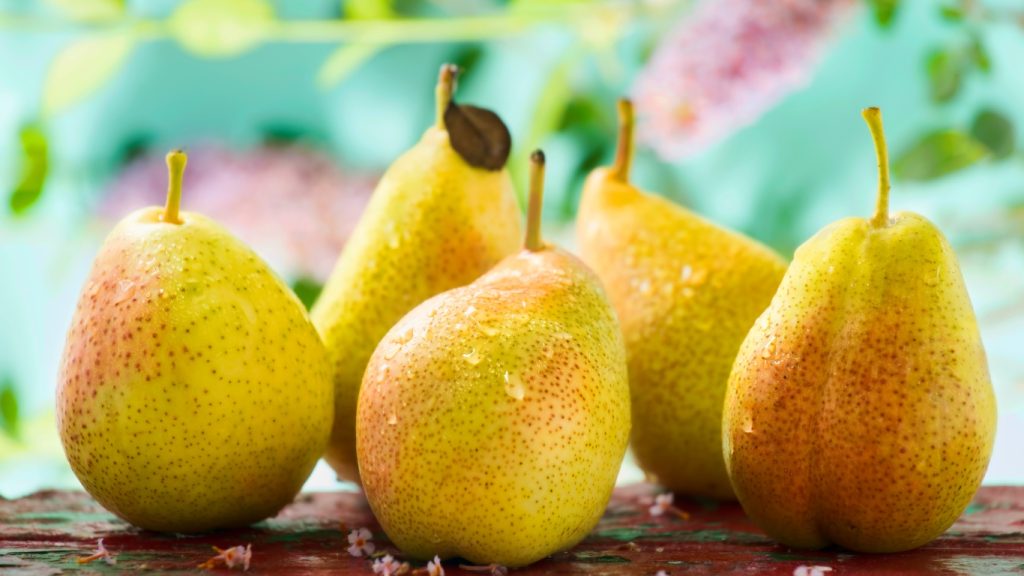
These are the following nutritional and health benefits of pear:
A. Nutritional value and fiber content of pears:
Pears are a delicious fruit that also offer several nutritional benefits. They are a good source of high fiber, which plays a crucial role in maintaining a healthy digestive system. Pears are low in calories and fat, making them a healthy choice for those watching their weight. They also contain essential vitamins and minerals, including vitamin C, vitamin K, potassium, and antioxidants.
B. Health benefits of pears:
- Digestive health: Pears are rich in dietary fiber, both soluble and insoluble, which aids in proper digestion and prevents constipation. The high fiber content promotes regular bowel movements and helps maintain a healthy digestive system.
- Heart health: Pears contain potassium, which helps regulate blood pressure and maintain heart health. The fiber in pears also helps lower cholesterol levels, reducing risk of heart disease.
- Weight management: Due to their high fiber content and low calorie count, pears can be a beneficial addition to a weight loss or weight management plan. The fiber helps create a feeling of fullness and reduces overeating.
- Antioxidant properties: Pears are rich in antioxidants such as vitamin C and other phytonutrients, which help protect cells from damage caused by harmful free radicals. This can contribute to a lower risk of chronic diseases, including certain types of cancer.
C. Ways to incorporate pears into the diet:
- Fresh and raw: Enjoy a ripe pear as a healthy and refreshing snack. Simply wash it, cut it into slices or quarters, and eat it as is.
- Salads: Add sliced pears to your favorite salad for a burst of sweetness and a crunchy texture. Pears pair well with ingredients like mixed greens, nuts, cheese, and a light dressing.
- Smoothies: Blend ripe pears with other fruits and yogurt to create a nutritious and fiber rich smoothie. You can also add spinach or kale for an extra boost of nutrients.
- Baking: Pears can be incorporated into baked goods such as pies, tarts, or muffins. They add natural sweetness and moisture to recipes.
- Grilled or roasted: Grill or roast pear slices to bring out their natural sweetness. They can be enjoyed as a side dish, added to sandwiches, or served with cheese.
- Preserves and jams: Make homemade pear preserves or jams to enjoy their flavor year round. Spread them on toast or use them as a topping for yogurt or oatmeal.
III. Avocado:

These are the following nutritional and health benefits of avocado:
A. Nutritional Value and Fiber Content:
- Avocados are nutrient dense fruits that provide a wide range of essential nutrients.
- They are a good source of healthy monounsaturated fats, which can help reduce bad cholesterol levels.
- Avocados are also rich in dietary fiber, with an average avocado containing about 10 grams of fiber.
B. Health Benefits:
- Heart Health:
- The monounsaturated fats in avocados have been linked to improved heart health by lowering LDL (bad) cholesterol levels and reducing risk of heart disease.
- Avocados also contain potassium, which helps regulate blood pressure and prevent hypertension.
- The monounsaturated fats in avocados have been linked to improved heart health by lowering LDL (bad) cholesterol levels and reducing risk of heart disease.
- Weight Management:
- Avocados are high in fiber, which promotes feelings of fullness and can help control appetite and reduce overeating.
- The healthy fats in avocados contribute to a sense of satisfaction and can aid in weight management.
- Avocados are high in fiber, which promotes feelings of fullness and can help control appetite and reduce overeating.
- Digestive Health:
- The high fiber content in avocados supports healthy digestion by adding bulk to stool, preventing constipation, and promoting regular bowel movements.
- Avocados also contain prebiotic fiber, which acts as food for beneficial gut bacteria, supporting a healthy gut microbiome.
- The high fiber content in avocados supports healthy digestion by adding bulk to stool, preventing constipation, and promoting regular bowel movements.
- Nutrient Absorption:
- Avocados enhance absorption of fat soluble nutrients such as vitamins A, D, E, and K when consumed with other foods.
- Adding avocados to salads or meals containing vegetables can increase absorption of important nutrients.
- Avocados enhance absorption of fat soluble nutrients such as vitamins A, D, E, and K when consumed with other foods.
C. Ways to Incorporate Avocados into the Diet:
- Salads and Sandwiches: Add sliced or diced avocados to salads, sandwiches, wraps, or burgers for a creamy texture and added nutritional value.
- Guacamole: Make homemade guacamole by mashing avocados with lime juice, diced tomatoes, onions, cilantro, and seasonings. Serve with whole-grain tortilla chips or as a topping for tacos and burritos.
- Smoothies: Blend avocados into smoothies for a creamy consistency and to boost fiber and nutrient content. Pair with fruits like berries or bananas for a delicious and nutritious drink.
- Avocado Toast: Spread mashed or sliced avocados on whole-grain toast and top with ingredients like tomatoes, feta cheese, or poached eggs for a nutritious and satisfying breakfast or snack.
- Dressings and Dips: Use avocados as a base for homemade dressings and dips, such as creamy avocado dressing or avocado hummus, to add flavor and health benefits to your meals.
IV. Raspberry:
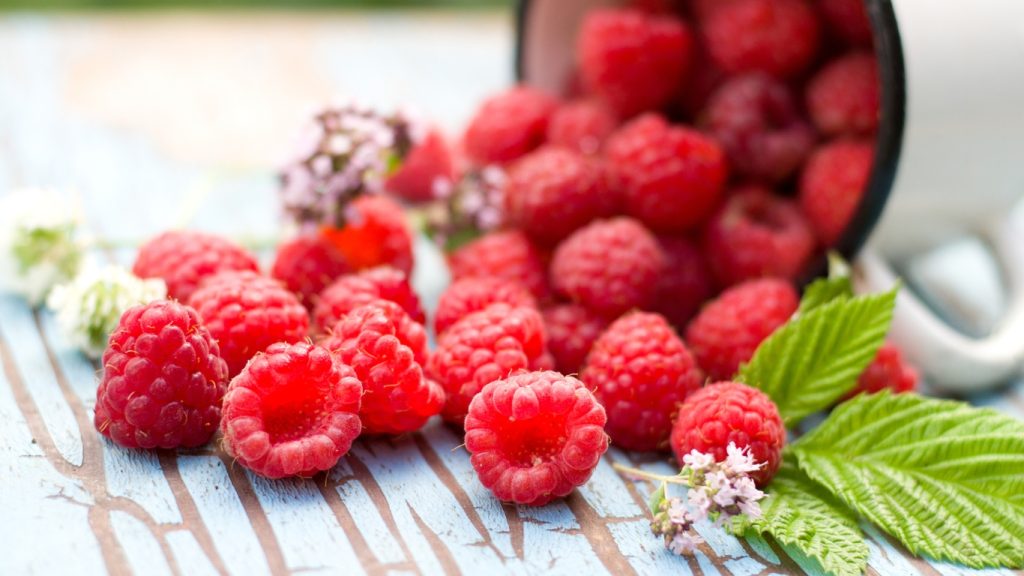
These are the following nutritional and health benefits of raspberry:
A. Nutritional value and fiber content:
- Raspberries are low in calories but rich in nutrients. They are a great source of vitamins C and K, manganese, and fiber.
- Fiber content: One cup of raspberries (approximately 123 grams) contains about 8 grams of fiber, which contributes to a significant portion of recommended daily intake.
B. Health benefits:
- Promotes digestion: High fiber content in raspberries helps promote healthy digestion by preventing constipation and maintaining regular bowel movements.
- Weight management: Fiber in raspberries contributes to a feeling of fullness, which can aid in weight management by reducing overeating and snacking between meals.
- Heart health: The antioxidants and phytonutrients present in raspberries help reduce inflammation and oxidative stress, which may lower risk of heart disease.
- Blood sugar control: The fiber and polyphenols in raspberries help regulate blood sugar levels and improve insulin sensitivity, making them beneficial for individuals with diabetes or those at risk.
- Cancer fighting properties: Raspberries contain various antioxidants, including ellagic acid, which has been shown to have anti-cancer effects and may help prevent certain types of cancers.
C. Ways to incorporate raspberries into the diet:
- Fresh raspberries can be enjoyed on their own as a snack or added to cereals, oatmeal, yogurt, or salads.
- They can be blended into smoothies or used as a topping for pancakes, waffles, or desserts.
- Frozen raspberries can be used in baking, such as muffins, cakes, or pies.
- Raspberry preserves or sauces can be made and used as spreads or added to savory dishes for a touch of sweetness.
V. Blackberries
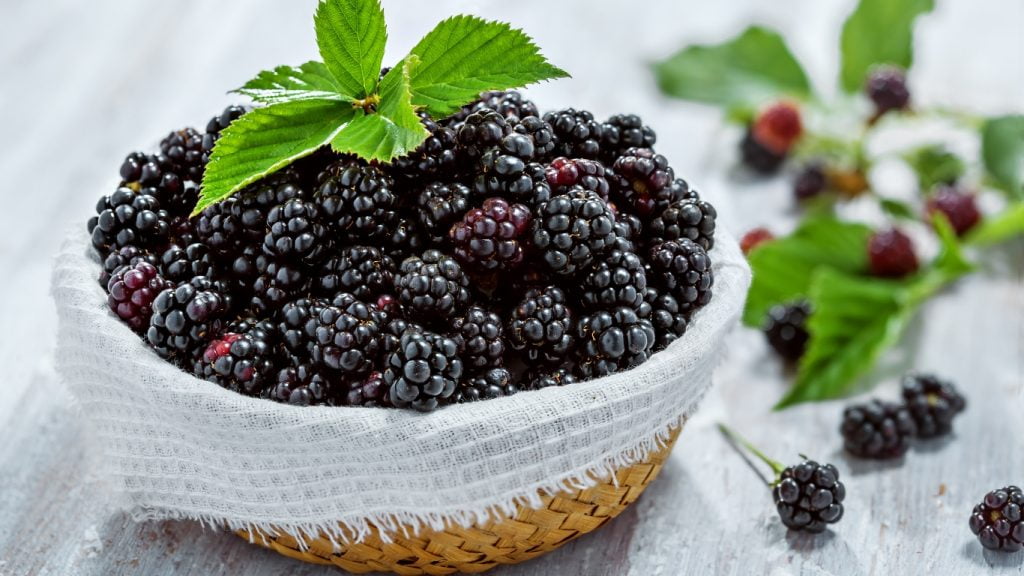
These are the following nutritional and health benefits of blackberries:
A. Nutritional value and fiber content:
Blackberries are small, dark berries that are packed with essential nutrients. Here is an overview of their nutritional value and high fiber content:
- Fiber: Blackberries are an excellent source of dietary fiber. A 1-cup serving of blackberries contains approximately 8 grams of fiber, which is around one-third of the recommended daily intake for adults.
- Vitamins and minerals: Blackberries are rich in vitamins C and K, providing approximately 30% and 36% of recommended daily intake, respectively. They also contain smaller amounts of vitamins A, E, and various B vitamins. In terms of minerals, blackberries offer notable amounts of manganese, copper, and magnesium.
- Antioxidants: Blackberries are known for their high antioxidant content. They contain anthocyanins, which give them their deep purple color and contribute to their antioxidant properties. Antioxidants help protect the body’s cells from damage caused by free radicals.
B. Health benefits:
Consuming blackberries can have several health benefits due to their nutritional profile and antioxidant content. Some key health benefits of blackberries include:
- Improved digestion: High fiber content in blackberries promotes healthy digestion and helps prevent constipation. Fiber also supports a healthy gut microbiome.
- Enhanced immune function: Blackberries’ vitamin C content strengthens immune system and helps body fight off infections and diseases.
- Heart health: The antioxidants and fiber in blackberries can contribute to a healthy cardiovascular system by reducing risk of heart disease. They may help lower cholesterol levels and maintain healthy blood pressure.
- Cognitive function: The antioxidants in blackberries have been linked to improved brain health and cognitive function, potentially reducing risk of age-related cognitive decline.
- Weight management: High fiber content in blackberries can help promote feelings of fullness and aid in weight management by reducing overall calorie intake.
C. Ways to incorporate blackberries into the diet:
Blackberries can be enjoyed in various ways as part of a healthy diet. Here are some suggestions on how to incorporate blackberries into your meals and snacks:
- Fresh and raw: Eat blackberries as a quick and nutritious snack on their own or mixed with other fruits.
- Smoothies: Blend blackberries with yogurt, milk, or plant based alternatives to create a delicious and fiber rich smoothie.
- Salads: Add blackberries to green salads for a burst of flavor and added antioxidants. They pair well with ingredients like spinach, feta cheese, and nuts.
- Baked goods: Use blackberries in muffins, cakes, or pies for a sweet and tangy twist. They can be incorporated into both traditional and healthier recipes.
- Sauces and jams: Blackberries can be cooked down into a sauce or turned into homemade jams, which can be used as toppings for pancakes, yogurt, or oatmeal.
VI. Kiwi
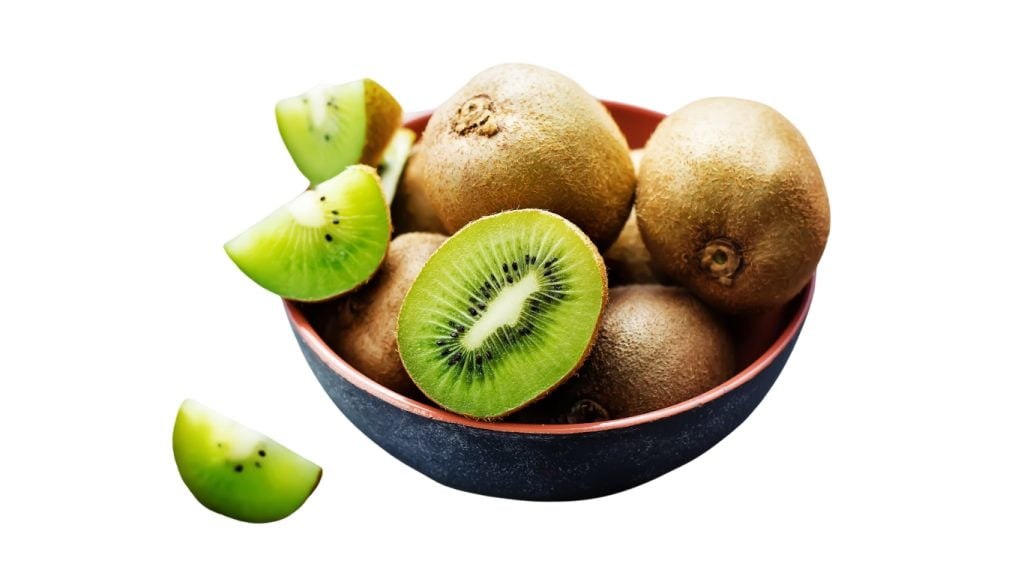
These are the following nutritional and health benefits of kiwi:
A. Nutritional value and fiber content:
- Kiwi is a nutrient-dense fruit that offers several essential vitamins and minerals.
- It is rich in fiber, with around 2.3 grams of fiber per 100 grams of fruit.
- Kiwi also contains vitamins C, E, and K, as well as potassium and folate.
B. Health benefits:
- Digestive health: High fiber content in kiwi helps promote healthy digestion by supporting regular bowel movements and preventing constipation.
- Immune system support: Kiwi is an excellent source of vitamin C, which is known to strengthen immune system, enhance wound healing, and protect against infections and diseases.
- Antioxidant properties: Kiwi is packed with antioxidants that help protect body against oxidative stress and reduce the risk of chronic diseases, such as heart disease and cancer.
- Eye health: Presence of vitamin C, vitamin E, and other antioxidants in kiwi contribute to maintaining healthy vision and reducing risk of age related macular degeneration.
- Skin health: Combination of vitamin C and antioxidants in kiwi promotes collagen synthesis, which is essential for maintaining healthy and youthful skin.
C. Ways to incorporate kiwi into the diet:
- Fresh fruit: Kiwi can be enjoyed as a standalone snack by simply peeling and eating it.
- Smoothies: Add peeled kiwi slices to your favorite smoothie recipe for a refreshing and nutritious boost.
- Fruit salads: Kiwi adds a delightful flavor and texture to fruit salads, making it a colorful addition to your plate.
- Salsa or relish: Dice kiwi and combine it with other ingredients like onions, peppers, and lime juice to create a tangy salsa or relish that complements grilled meats or fish.
- Desserts: Kiwi can be used in various desserts, such as fruit tarts, pies, or even as a topping for yogurt or ice cream.
- Marinades: Kiwi contains enzymes that can help tenderize meat. Puree kiwi and use it as a natural meat tenderizer in marinades.
VII. Blueberries
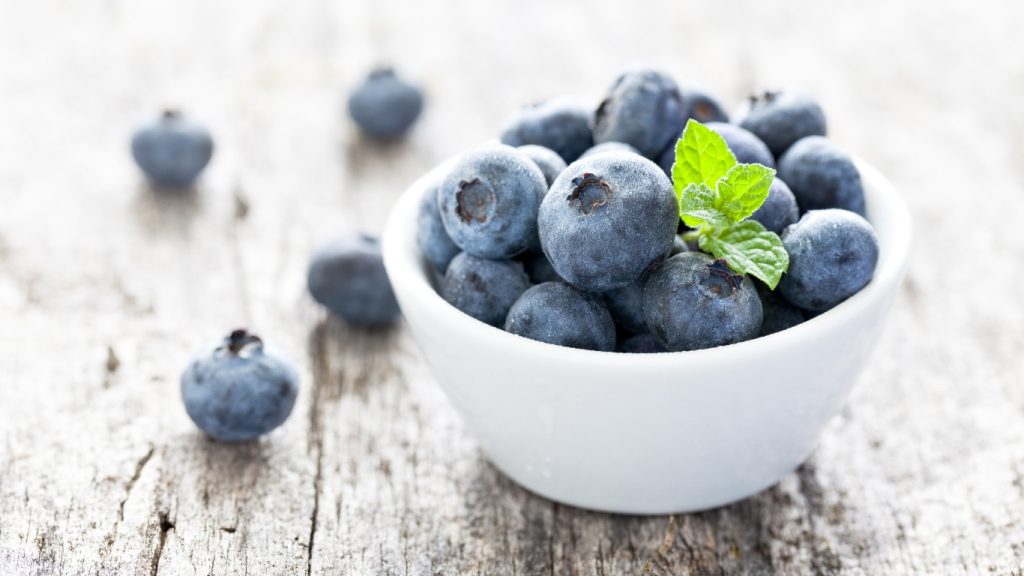
These are the following nutritional and health benefits of blueberries:
A. Nutritional value and fiber content:
- Blueberries are small, round fruits that are rich in high fiber.
- They are low in calories and high in fiber, making them a healthy addition to a balanced diet.
- A 1-cup (148 grams) serving of blueberries contains approximately:
- Calories: 84
- Fiber: 3.6 grams
- Vitamin C: 14.4 milligrams (24% of daily recommended intake)
- Vitamin K: 28.6 micrograms (36% of daily recommended intake)
- Manganese: 0.5 milligrams (25% of daily recommended intake)
- Antioxidants: Blueberries are also rich in antioxidants, particularly flavonoids like anthocyanins, which give them their deep blue/purple color.
B. Health benefits:
- Promote heart health: The high levels of antioxidants in blueberries help reduce oxidative stress and inflammation, which are risk factors for heart disease.
- Support brain health: Blueberries have been linked to improved brain function and memory due to their antioxidants and their ability to reduce oxidative stress in brain.
- Aid in digestion: Blueberries are a good source of dietary fiber, which helps regulate digestion, prevent constipation, and support a healthy gut microbiome.
- Support immune system: The vitamin C content in blueberries helps boost immune system and protects against common illnesses.
- Reduce risk of chronic diseases: The antioxidants in blueberries have been associated with a reduced risk of certain cancers, diabetes, and age related macular degeneration.
C. Ways to incorporate blueberries into the diet:
- Fresh or frozen: Enjoy a handful of fresh blueberries as a healthy snack or add them to smoothies, yogurt, or oatmeal for a burst of flavor and added fiber.
- Baked goods: Incorporate blueberries into muffins, pancakes, or bread for a nutritious twist.
- Salads: Add blueberries to salads for a pop of color and a sweet, tangy taste.
- Toppings: Sprinkle blueberries on top of cereal, granola, or desserts like ice cream or pudding.
- Sauces and jams: Make blueberry sauce or jam to use as a topping for pancakes, waffles, or toast.
VIII. Guava
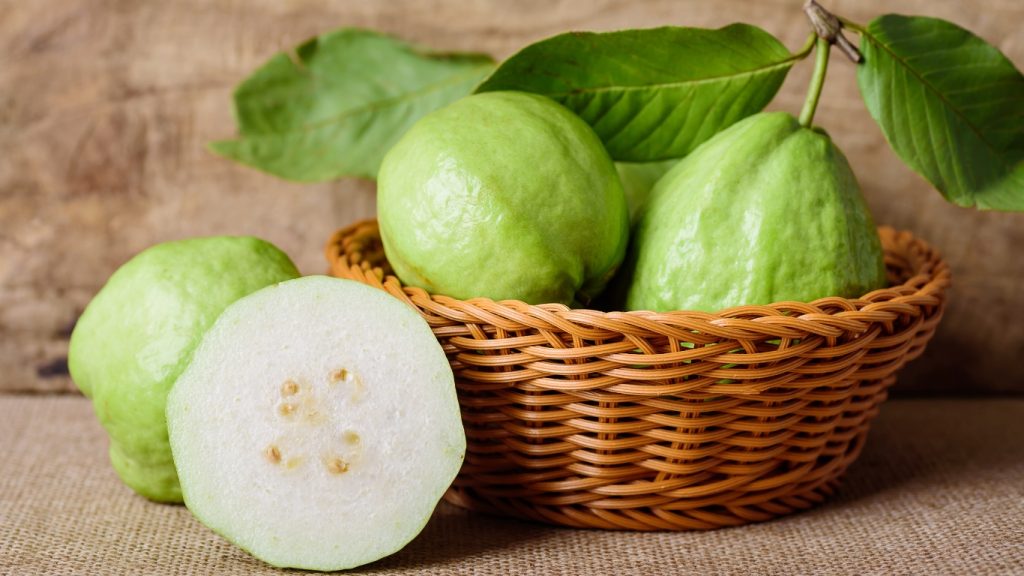
These are the following nutritional and health benefits of guava:
A. Nutritional value and fiber content:
- Guava is a tropical fruit known for its rich nutritional profile.
- It is a good source of dietary fiber, with approximately 5.4 grams of fiber per 100 grams of fruit.
- Guava also provides essential vitamins and minerals such as vitamin C, vitamin A, potassium, and folate.
- Additionally, it contains antioxidants and phytochemicals that contribute to its health benefits
B. Health benefits:
- Promotes digestive health: The high fiber content in guava aids digestion by promoting regular bowel movements, preventing constipation, and maintaining a healthy gut.
- Boosts immune system: Guava is loaded with vitamin C, which helps strengthen immune system and protects against infections and illnesses.
- Supports heart health: The high fiber, potassium, and antioxidants in guava contribute to cardiovascular health by reducing cholesterol levels, improving blood pressure, and reducing risk of heart disease.
- Enhances skin health: The antioxidants in guava help combat free radicals, preventing damage to skin and reducing signs of aging. The vitamin C content also promotes collagen production, keeping skin healthy and youthful.
- Regulates blood sugar levels: The high fiber content in guava helps regulate blood sugar levels, making it a suitable fruit for individuals with diabetes.
- Promotes weight loss: Guava is low in calories and high in fiber, which helps promote feelings of fullness and aids in weight management.
C. Ways to incorporate guava into the diet:
- Fresh guava: Enjoy guava as a delicious and nutritious snack by simply washing fruit, cutting it into slices or quarters, and eating it raw.
- Guava smoothie: Blend guava with other fruits like bananas, berries, or oranges to create a refreshing and fiber-rich smoothie.
- Guava salad: Combine diced guava with leafy greens, such as spinach or arugula, and add some nuts or seeds for an extra crunch.
- Guava salsa: Create a tropical twist on salsa by mixing diced guava with tomatoes, onions, cilantro, lime juice, and a touch of spice. Enjoy it as a topping for grilled meats or as a dip with whole-grain chips.
- Guava desserts: Use guava as an ingredient in desserts like guava pie, guava jelly, or guava sorbet for a sweet and fiber-packed treat.
IX. Orange
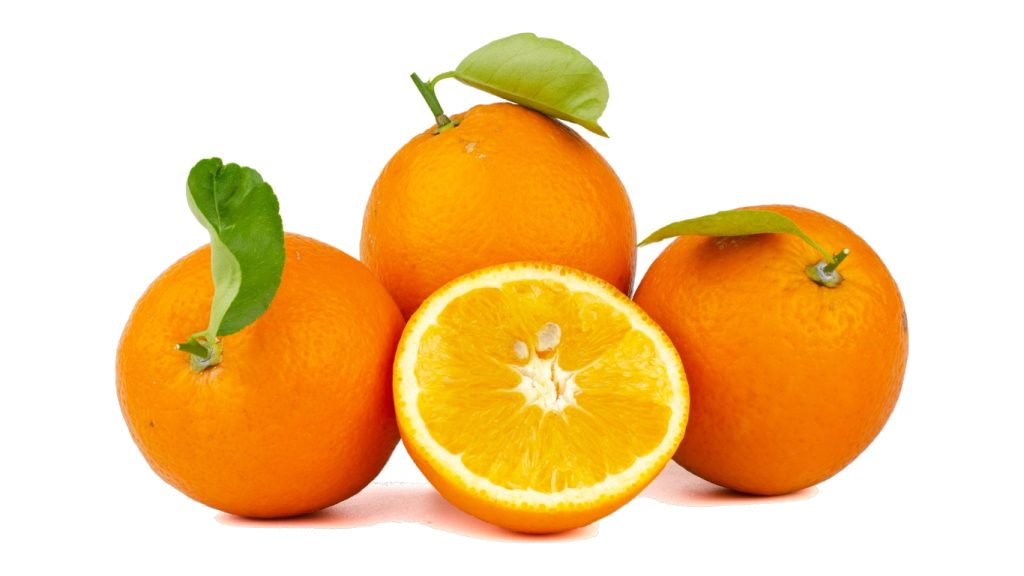
These are the following nutritional and health benefits of orange:
A. Nutritional value and fiber content of Oranges:
Oranges are a popular citrus fruit known for their refreshing taste and vibrant color. They are also highly nutritious and provide various essential nutrients. Here are some key nutritional values of oranges:
- Fiber content: Oranges are a good source of dietary fiber. On average, a medium-sized orange contains approximately 3 grams of fiber.
B. Health benefits of Oranges:
Oranges offer several health benefits due to their rich nutrient profile. Some notable health benefits include:
- High in Vitamin C: Oranges are renowned for their high vitamin C content. This vitamin is crucial for boosting immune system, promoting collagen synthesis for healthy skin, and aiding in absorption of iron.
- Antioxidant properties: Oranges contain antioxidants like flavonoids and vitamin C, which help neutralize harmful free radicals in body. Antioxidants play a vital role in reducing risk of chronic diseases, such as heart disease and certain types of cancer.
- Support heart health: Oranges are a heart-healthy fruit. The presence of soluble fiber, such as pectin, helps lower cholesterol levels in blood. Additionally, flavonoids found in oranges have been associated with a reduced risk of heart disease.
- Hydration and electrolyte balance: Oranges have high water content, aiding in hydration. They also contain electrolytes like potassium, which help maintain fluid balance in the body and support proper muscle function.
- Digestive health: The fiber content in oranges promotes healthy digestion and helps prevent constipation. It adds bulk to stool, aiding in regular bowel movements.
C. Ways to incorporate oranges into the diet:
Including oranges in your diet is both delicious and beneficial. Here are some simple ways to incorporate oranges into your meals:
- Freshly squeezed juice: Start your day with a glass of freshly squeezed orange juice to enjoy its natural sweetness and high vitamin C content.
- Fruit salad: Add slices or segments of oranges to your fruit salad for a refreshing burst of flavor and added fiber.
- Smoothies: Blend oranges with other fruits, such as bananas or berries, to create a nutritious and flavorful smoothie.
- Salad topping: Sprinkle orange segments over green salads for a zesty twist and extra fiber.
- Snack on whole oranges: Enjoy oranges as a healthy snack on their own. Peel and eat the segments for a quick and portable fiber-rich treat.
X. Banana
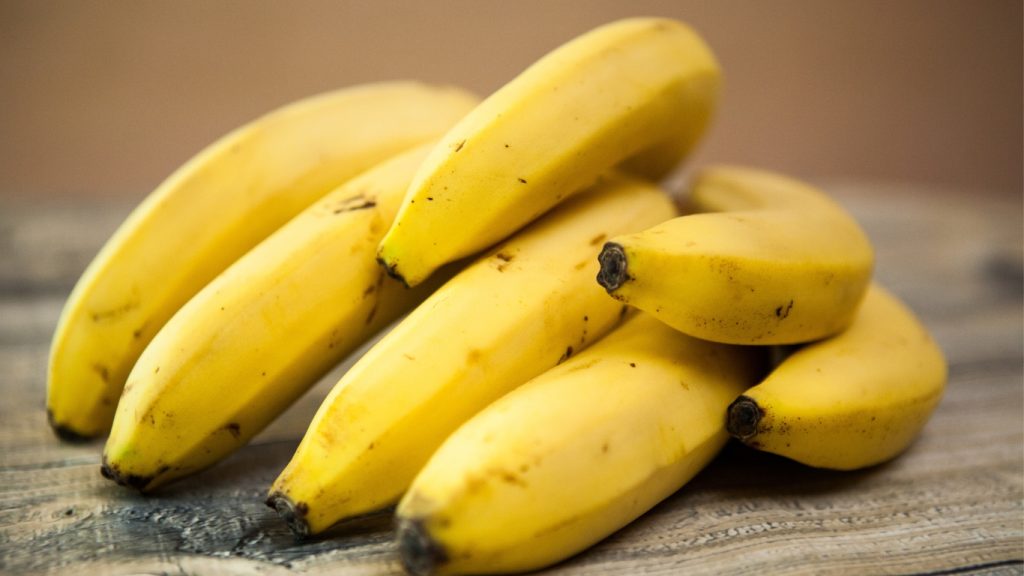
These are the following nutritional and health benefits of banana:
A. Nutritional value and fiber content of bananas:
Bananas are not only delicious but also packed with essential nutrients. Here are the nutritional highlights of a medium sized banana (approximately 118 grams):
- Calories: A medium sized banana contains about 105 calories, making it a relatively low calorie fruit option.
- Carbohydrates: Bananas are primarily composed of carbohydrates, with around 27 grams per medium-sized fruit. They provide a quick source of energy.
- Fiber: Bananas are a good source of dietary fiber, containing approximately 3 grams per medium-sized banana. Fiber is essential for maintaining a healthy digestive system and promoting regular bowel movements.
- Vitamins: Bananas are rich in various vitamins, including vitamin C, vitamin B6, and vitamin A. Vitamin C helps boost the immune system, vitamin B6 is important for brain development and function, and vitamin A is beneficial for eye health.
- Minerals: Bananas are a good source of several minerals, such as potassium, magnesium, and manganese. Potassium helps maintain proper heart and muscle function, while magnesium and manganese are involved in various metabolic processes in the body.
B. Health benefits of bananas:
Consuming bananas offers numerous health benefits, including:
- Digestive health: The high fiber content in bananas promotes healthy digestion and helps prevent constipation. Bananas also contain natural enzymes that aid in breaking down food.
- Heart health: Potassium in bananas helps regulate blood pressure and maintain a healthy heart. It plays a crucial role in balancing fluids and electrolytes in body.
- Energy and exercise: Bananas are a great source of carbohydrates and provide a quick and sustained energy boost. They are often recommended as a pre or post workout snack to replenish glycogen stores and prevent muscle cramps.
- Nutrient absorption: The fiber in bananas helps improve nutrient absorption in the gut, ensuring that body effectively utilizes vitamins and minerals from other foods.
- Mood regulation: Bananas contain an amino acid called tryptophan, which is converted into serotonin, a neurotransmitter that helps regulate mood and promotes a sense of well being.
C. Ways to incorporate bananas into the diet:
Bananas are versatile and can be enjoyed in various ways. Here are some ideas to incorporate bananas into your diet:
- Fresh fruit: Enjoy a ripe banana as a healthy snack on its own.
- Smoothies: Blend bananas with other fruits, yogurt, and a liquid of your choice to make a nutritious and delicious smoothie.
- Baked goods: Add mashed bananas to pancake or muffin batter for added moisture and natural sweetness.
- Breakfast: Slice bananas onto cereal, oatmeal, or yogurt to add flavor, texture, and fiber.
- Frozen treats: Freeze ripe bananas and blend them to make a creamy and healthy ice cream alternative.
- Toppings: Use sliced bananas as a topping for toast, peanut butter sandwiches, or desserts like pancakes and waffles.
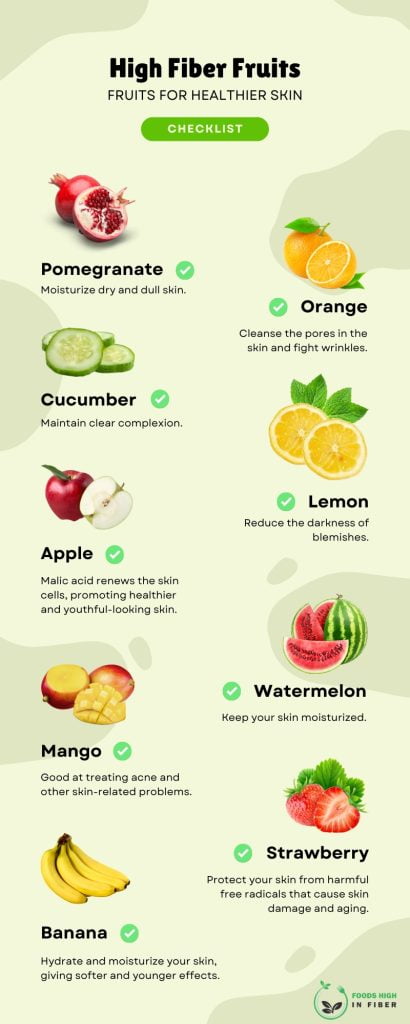
Conclusion
In conclusion, high fiber fruits are an essential element of a healthy and balanced diet. Throughout this figure, we’ve explored the top 10 high fiber fruits and their nutritive value, health benefits, and ways to incorporate them into our diurnal reflections.
We began by emphasizing the significance of fiber in our diet, which aids in digestion, promotes malnutrition, regulates blood sugar situations, and supports heart health. By including high fiber fruits in our reflections, we can fluently boost our fiber input while enjoying a variety of succulent flavors.
Apples, with their emotional high fiber fruits content, offer multitudinous health benefits similar to better gut health and reduced threat of habitual conditions. Pears also give substantial fiber and contribute to digestive health and weight operation. Avocados, known for their healthy fats, also contain a good quantity of fiber and offer benefits like better nutrient immersion and heart health.
Snorts and blackberries are rich in fiber and antioxidants, which play a pivotal part in reducing inflammation and supporting a healthy vulnerable system. Kiwi, blueberries, and guava are also packed with fiber, along with a cornucopia of vitamins and minerals that contribute to overall well being.
Oranges, while renowned for their vitamin C content, are also a good source of high fiber that aids in digestion and supports heart health. Lastly, bananas provide a substantial amount of fiber, potassium, and other essential nutrients, promoting healthy digestion and maintaining proper electrolyte balance.

